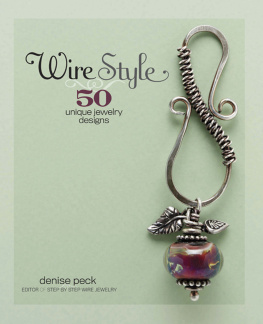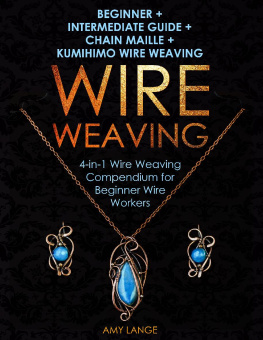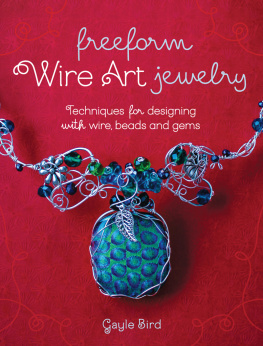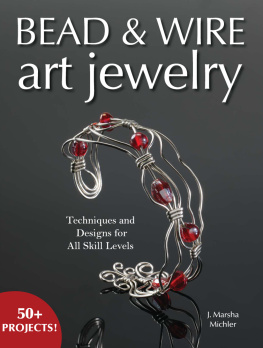Denise Peck & Jane Dickerson

Contents
Welcome to The Wireworkers Companion. Inside youll find everything you need to get started and grow your skills in wireworking: from the most basic tools and materials to fascinating advanced techniques, including examples of chain maille and weaving. Whether you are just starting out or wire is already your favorite medium, this book can be an invaluable resource. As our passion grew for wireworking, we felt the need for a reference guide, and we hope youll find this a handy tool.
The versatility of wire makes it an ideal medium to work with in jewelry. Wireworking offers an abundance of beautiful materials you can work with in a wide range of textures, thicknesses, and hues. Very fine wire can produce delicate, elegant designs, and its soft malleability makes it very easy to work with. Heavier gauge wire can be hammered and textured and can result in dramatic, funky, chunky statement pieces. The beauty of working with wire is that you can make everything from a fine delicate finding to a bold, dramatic focal point. Add to that the unique qualities of different metals, including their responses to being oxidized and colorized, and the possibilities are truly endless.
Its easy to fall in love with wireworking, and we hope that as you build your skills and refine your techniques, this will be a book you will turn to again and again.
Denise Peck
Jane Dickerson
In this chapter you will become more familiar with the basics of wire: What metal(s) it can be made of, the contrasting properties of each, and the many forms that wire can take.
Wire comes in a multitude of materials, giving you the flexibility of working within your price range. Base metals are inexpensive and readily available. Precious metals, such as silver and gold, are more expensive and can be found at jewelry suppliers. A great way to conserve on precious metals is to use them as accents with other less expensive metals, such as combining some sterling with copper.
BASE METAL refers to common and inexpensive metals such as iron, nickel, and copper. Base metals can also be alloys, or mixtures of these metals. And they all corrode and tarnish easily when exposed to air or moisture.
FERROUS METALS contain iron and therefore are magnetic. They corrode quite easily. Ferrous metals include steel and stainless steel.
NONFERROUS METALS , such as aluminum, copper, and tin, do not contain iron and are not magnetic. They resist corrosion more than ferrous metals.
PRECIOUS METALS are by definition relatively scarce and therefore expensive. In jewelry making, precious metals usually refer to gold, silver, and platinum. Theyre quite corrosion-resistant. And because theyre a traded commodity, prices fluctuate constantly.
REACTIVE METALS , such as titanium and niobium, undergo a chemical reaction when combined with other elements. Niobium is a favorite for jewelry making. Originally silver/white, it turns beautiful rainbow colors in an anodizing process. Its a strong and nonallergenic metal.
Each wire type has specific properties; some are soft and malleable and others are harder to manipulate. Knowing the properties of your wire is important before you begin working on a piece. Later in the book you will learn how to soften and harden your wire to suit your design.
TIP: The purer the metal, the less it tarnishes. Thats what gives fine silver and Argentium their antitarnish properties. Metal alloys, especially those that contain copper, are prone to tarnishing.
ALUMINUM wire is tarnish-resistant, lightweight, and very easy to manipulate. It comes in a variety of colors and gauges. Although the color is applied multiple times during the manufacturing process, it can scratch, and caution is needed when manipulating the wire with tools. Use Tool Magic rubber coating on your tools to prevent scratching or marring the finish of the aluminum.

ARGENTIUM wire is at least 93.5% silver and tarnish-resistant. It solders and fuses without oxidizing and yields a very high polish.

BRASS wire is a stiffer, harder metal, making it a bit more difficult to work with. It comes in two colors, yellow and red. Yellow brass wire is 6070% copper and 3040% zinc. Red brass wire has a warmer hue and is 85% copper and 15% zinc. Use patina to color brass instead of liver of sulfur, which only slightly dulls the color.

BRONZE wire is a copper alloy. It is stronger than copper and harder to work with. It is a warm golden color and can be darkened with liver of sulfur.

COPPER wire is inexpensive and great to use as practice wire. It is soft and malleable and comes in a variety of gauges. Sometimes the color can vary from spool to spool, so take note of that. Copper responds well to patina.

CRAFT wire is usually a copper core covered with a coating of color. It is soft and malleable and comes in a variety of colors and gauges. There are several brands of craft wire on the market. To avoid nicking the color coating when manipulating the wire, first cover your pliers jaws in masking tape or Tool Magic.

FINE SILVER wire is 99.9% pure silver. It is soft and malleable, and it can be fused easily with a hand torch. It does not tarnish as quickly as sterling silver and does not oxidize in a flame. It can be oxidized in liver of sulfur or another blackening agent.

TIP: If you dont know whether your wire is sterling or fine silver, hold a piece of the wire in a flame; if it turns black, its sterling. If it doesnt turn black, it is fine silver.
GERMAN-STYLE wire is nickel-free silver-plated copper wire with an antitarnish coating; it is also available in brass. It comes in a variety of gauges and shapes and has a medium temper, which is harder than craft wire and softer than half-hard sterling silver.

GOLD wire is an alloy that does not tarnish. It is very expensive, and the amount of gold is measured in karatsthe higher the number, the greater the percentage of gold.

GOLD-FILLED wire is made from layers of 12k or 14k gold that are bonded by heat and pressure to a brass base. It comes in a variety of gauges and hardnesses. Gold-filled is superior to gold-plated and will not chip or flake when manipulated. It looks like gold without the cost.




















